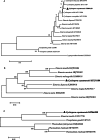Cyclospora cayetanensis infection in humans: biological characteristics, clinical features, epidemiology, detection method and treatment
- PMID: 31699163
- PMCID: PMC10317703
- DOI: 10.1017/S0031182019001471
Cyclospora cayetanensis infection in humans: biological characteristics, clinical features, epidemiology, detection method and treatment
Abstract
Cyclospora cayetanensis, a coccidian parasite that causes protracted and relapsing gastroenteritis, has a short recorded history. At least 54 countries have documented C. cayetanensis infections and 13 of them have recorded cyclosporiasis outbreaks. Cyclospora cayetanensis infections are commonly reported in developing countries with low-socioeconomic levels or in endemic areas, although large outbreaks have also been documented in developed countries. The overall C. cayetanensis prevalence in humans worldwide is 3.55%. Among susceptible populations, the highest prevalence has been documented in immunocompetent individuals with diarrhea. Infections are markedly seasonal, occurring in the rainy season or summer. Cyclospora cayetanensis or Cyclospora-like organisms have also been detected in food, water, soil and some other animals. Detection methods based on oocyst morphology, staining and molecular testing have been developed. Treatment with trimethoprim-sulfamethoxazole (TMP-SMX) effectively cures C. cayetanensis infection, whereas ciprofloxacin is less effective than TMP-SMX, but is suitable for patients who cannot tolerate co-trimoxazole. Here, we review the biological characteristics, clinical features, epidemiology, detection methods and treatment of C. cayetanensis in humans, and assess some risk factors for infection with this pathogen.
Keywords: Biological characteristic; Cyclospora cayetanensis; clinical feature; detection method; epidemiology; treatment.
Figures



References
-
- Abanyie F, Harvey RR, Harris JR, Wiegand RE, Gaul L, Desvignes-Kendrick M, Irvin K, Williams I, Hall RL, Herwaldt B, Gray EB, Qvarnstrom Y, Wise ME, Cantu V, Cantey PT, Bosch S, DA Silva AJ, Fields A, Bishop H, Wellman A, Beal J, Wilson N, Fiore AE, Tauxe R, Lance S, Slutsker L, Parise M and Multistate Cyclosporiasis Outbreak Investigation Team (2015) 2013 multistate outbreaks of Cyclospora cayetanensis infections associated with fresh produce: focus on the Texas investigations. Epidemiology & Infection 143, 3451–3458. - PMC - PubMed
-
- Aksoy U, Marangi M, Papini R, Ozkoc S, Bayram Delibas S and Giangaspero A (2014) Detection of Toxoplasma gondii and Cyclospora cayetanensis in Mytilus galloprovincialis from Izmir Province coast (Turkey) by real time PCR/high-resolution melting analysis (HRM). Food Microbiology 44, 128–135. - PubMed
-
- Alakpa G, Fagbenro-Beyioku AF and Clarke SC (2002) Cyclospora cayetanensis in stools submitted to hospitals in Lagos, Nigeria. International Journal of Infectious Diseases 6, 314–318. - PubMed
-
- Al-Megrin WA (2010) Intestinal parasites infection among immunocompromised patients in Riyadh, Saudi Arabia. Pakistan Journal of Biological Sciences 13, 390–394. - PubMed
Publication types
MeSH terms
Substances
LinkOut - more resources
Full Text Sources

